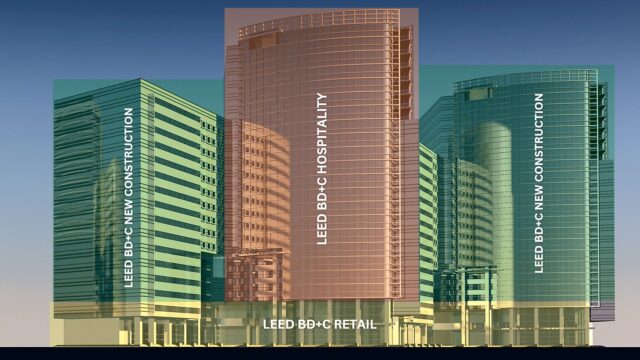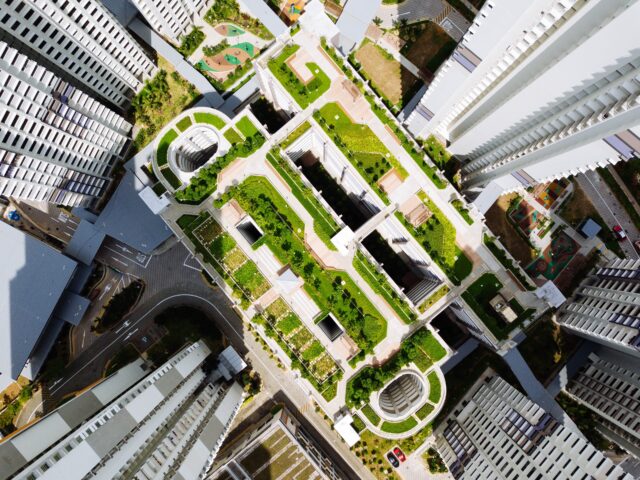The 40/60 rule is essential to understand when selecting which LEED v4.1 rating system to use for a project. This is especially helpful in a scenario where a project is eligible for more than one rating system. The 40/60 rule helps project teams to best decide which rating system to use, based on a simple calculation.
To learn more about the LEED building certification process, as well as how you can increase your knowledge by becoming LEED accredited, check out our free intro training to becoming a LEED GA.

What is the 40/60 rule?
The United States Green Building Council (USGBC) provides the 40/60 rule to use when selecting an appropriate rating system for a project. If a project is eligible for more than one rating system, the USGBC recommends the following:
Assign a rating system to each square foot/meter of the building footprint. The resulting percentages of rating systems per building footprint will be used to select the most appropriate rating system.
- If a rating system covers less than 40% of the gross floor area of a project, the system is not appropriate for use on the project.
- If a rating system covers more than 60% of the gross floor area of a project, the system must be used for the project.
- Should a rating system be covered between 40% and 60% of the gross floor area of a project, the project teams can choose a rating system that they find most appropriate.
It is important to remember that the entire footprint of the project must be certified under one rating system, and must adhere to all the prerequisites and selected credits of the system, regardless of whether it is a multi-use/mixed-design project that may fit into more than one rating system.
What is the purpose of the 40/60 rule?
Because there are so many rating systems to choose from, project teams are often unsure which system they can choose, for a project that may be eligible for more than one system. This is where the 40/60 rule is used to guide project teams in the selection of an appropriate rating system.
It is up to project teams to make the final decision of which system they want to use. However, the USGBC reserves the right to notify a project team when the system they selected is not appropriate, and they will consequently have to change their selection to a system that is better suited for the project. This is why it is advised that project teams rely on the 40/60 rule.
How to use the 40/60 rule
In a scenario where a project team may be working on a mixed-use development that consists of retail space, new apartments, and a hotel, the 40/60 rule is used to decide on a rating system:
1. Calculate the total sqft of the project areas that fall under a specific rating system
- 100,000 sqft of hotel Space = 25% of project footprint for LEED BD + C Hospitality
- 250,000 sqft of new residences = 62.5% of project footprint for LEED BD + C New Construction
- 50,000sqft of retail space = 12.5% of project footprint for LEED BD + C Retail

2. Decide on a rating system based on the resulting percentages according to the 40/60 rule
Because the LEED BD + C Hospitality and LEED BD + C Retail rating systems each cover less than 40% of the project footprint, these rating systems should not be used.
Because the LEED BD + C New Construction rating system covers more than 60% of the project footprint, this rating system should be used to certify the whole project.
LEED rating systems explained
There are many rating systems across both the LEED v4 and LEED v4.1 adaptations that project teams can choose from. Here is a basic rundown of the rating systems adaptations in the latest LEED v4.1. The USGBC offers a full explanation of all the rating systems in LEED v4 and v4.1.
Building Design and Construction (BD+C)
The LEED Building Design and Construction (BD+C) rating system is used for buildings that are newly constructed or undergoing a major renovation. For this rating system to be used for certification, at least 60% of the gross floor area of the project must be complete by the time a building is to undergo certification. This does not include LEED BD+C: Core and Shell development.
The LEED BD+C rating system is the most extensive rating system and requires a good understanding of the LEED framework to properly apply. Archiroots offers the fastest, simplest and cheapest way to become LEED accredited and guarantee you pass the exam on the first try. Enroll in our LEED AP BD+C training today, and join over +2000 students worldwide who received the accreditation in just 2 weeks.
Interior Design and Construction (ID+C)
The LEED Interior Design and Construction (ID+C) rating system is used for interior spaces that are undergoing a a complete interior fit-out. Similar to the LEED BD+C rating system, at least 60% of the gross floor area of the project must be complete by the time the project is to undergo certification.
For LEED ID+C projects, spaces are not considered to be complete before they include the furnishings, fixtures and equipment needed for the space to operate on a regular basis.
Residential BD+C
The LEED v4.1 framework introduced a new approach to residential projects, combining the most relevant points from the BD+C and other residential rating systems, merging with the most important factors of the residential market.
The new multifamily selections in LEED v4.1 Residential BD+C is now the required rating system for all single- and multifamily projects. Any residential project that uses LEED v4.1 may not use LEED BD+C.
Residential BD+C covers buildings that are undergoing new construction or major renovations. Similar to other rating systems, at least 60% of the gross floor area of the project must be complete by the time the project is to undergo certification. This does not include LEED Residential BD+C for Multifamily Core and Shell Homes.

Cities and Communities
Cities and communities are also eligible for LEED certification in certain circumstances. Where ‘cities’ are defined as political jurisdictions or places that have public sector governance like a mayor.
‘Communities’ are defined as an urbanized location that is not a ‘city’. There are two options available for LEED for Cities and Communities:
Plan and design: New cities and communities that are still in the planning/design stage
Existing: Cities and communities that are more than 75% built.
Building Operations and Maintenance (O+M)
LEED for Building Operations and Maintenance (O+M) is used for buildings/spaces that are fully operational and has been occupied for at least one year. Projects eligible for certification may be undergoing improvement work with little to no construction.
Next steps in learning to work with LEED
The LEED framework is very extensive and covers a vast variety of topics and systems. Once you are ready to take the next steps in familiarizing yourself with LEED, you can start the path to becoming LEED accredited through our LEED Green Associate training and LEED AP BD + C training, as well as our practice tests, to guarantee passing the exam on your first try and becoming a LEED accredited professional in just 2 weeks!



